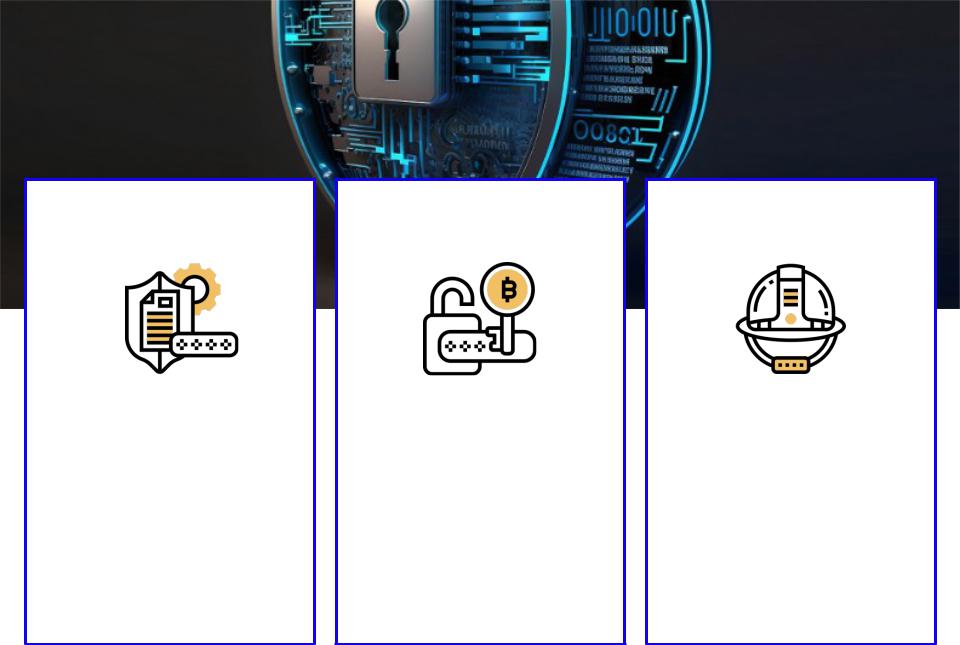
- •PROTECTIN G PERSONAL INFORMATIO N ON THE WEB
- •THE IMPORTANCE OF PROTECTING PERSONAL INFORMATION ON THE WEB
- •UNDERSTANDING THE RISKS OF SHARING PERSONAL INFORMATION ONLINE
- •TIPS AND TRICKS TO SAFEGUARD YOUR PERSONAL INFORMATION ONLINE
- •COMMON CYBERSECURITY THREATS AND HOW TO PROTECT YOURSELF
- •THE ROLE OF PASSWORD MANAGEMENT
- •HOW TO IDENTIFY AND AVOID PHISHING AND SCAM EMAILS
- •PROTECTING YOUR PRIVACY ON SOCIAL MEDIA PLATFORMS
- •THE FUTURE OF PERSONAL INFORMATION PROTECTION AND CYBERSECURITY
- •THANK

PROTECTIN G PERSONAL INFORMATIO N ON THE WEB

THE IMPORTANCE OF PROTECTING PERSONAL INFORMATION ON THE WEB
1. Privacy and Security
Protecting personal information is crucial for maintaining privacy and security online.
2. Identity Theft
Failure to protect personal information can lead to identity theft, resulting in financial loss and reputational damage.
3. Legal and Ethical Obligations
Businesses have legal and ethical obligations to protect customer data from unauthorized access or misuse.

UNDERSTANDING THE RISKS OF SHARING PERSONAL INFORMATION ONLINE
1. Cybercriminals and Hackers
Cybercriminals and hackers exploit personal information for various malicious activities.
2. Data Tracking and Profiling
Sharing personal information online can lead to targeted advertisements and invasion of privacy.
3. Social Engineering Attacks
Cybercriminals use personal information to manipulate individuals into revealing sensitive data or performing malicious actions.

TIPS AND TRICKS TO SAFEGUARD YOUR PERSONAL INFORMATION ONLINE
1. Use Strong and Unique Passwords
Create complex passwords and avoid reusing them for multiple accounts.
2. Enable Two-Factor Authentication
Add an extra layer of security by requiring a second form of authentication to access accounts.
3. Keep Software and Devices Updated
Regularly update software and devices to patch security vulnerabilities.

COMMON CYBERSECURITY THREATS AND HOW TO PROTECT YOURSELF
1. Malware and Viruses
Install reputable antivirus software and be cautious when downloading files or visiting suspicious websites.
2. Phishing Attacks
Be vigilant of suspicious emails, messages, or websites that attempt to trick users into revealing personal information.
3. Social Engineering
Be cautious of social engineering tactics, such as impersonation or manipulation, used to deceive individuals.

THE ROLE OF PASSWORD MANAGEMENT
IN PROTECTING PERSONAL
INFORMATION
1. Password Managers |
2. Encryption and Storage |
Use password |
Password |
management |
managers encrypt |
tools to securely |
and store |
store and |
passwords, |
generate unique |
ensuring they are |
passwords. |
protected from |
|
unauthorized |
|
access. |
3. Convenience and Security
Password managers provide a convenient and secure way to manage passwords for various online accounts.

HOW TO IDENTIFY AND AVOID PHISHING AND SCAM EMAILS
1. Check the Sender's Email Address
Verify the sender's email address and look for any suspicious or unusual elements.
2. Avoid Clicking on Suspicious Links
Hover over links to preview the URL and avoid clicking on suspicious or unfamiliar links.
3. Be Wary of Urgent or Threatening Language
Phishing emails often use urgency or threats to manipulate recipients into taking immediate action.

PROTECTING YOUR PRIVACY ON SOCIAL MEDIA PLATFORMS
1. Review Privacy Settings
Regularly review and adjust privacy settings on social media platforms to control the visibility of personal information.
2. Be Selective with Friend Requests
Only accept friend requests from individuals you know and trust.
3. Think Before You Share
Exercise caution when sharing personal information, photos, or location details on social media.

THE FUTURE OF PERSONAL INFORMATION PROTECTION AND CYBERSECURITY
1. Advancements in Technology
Technological advancements, such as AI and blockchain, will play a vital role in enhancing personal information protection.
2. Increased Awareness and Education
Education and awareness campaigns will help individuals and organizations better understand the importance of cybersecurity.
3. Collaboration and Regulation
Collaboration between governments, organizations, and individuals is crucial to establish effective regulations and standards for personal information

THANK
YOU!
